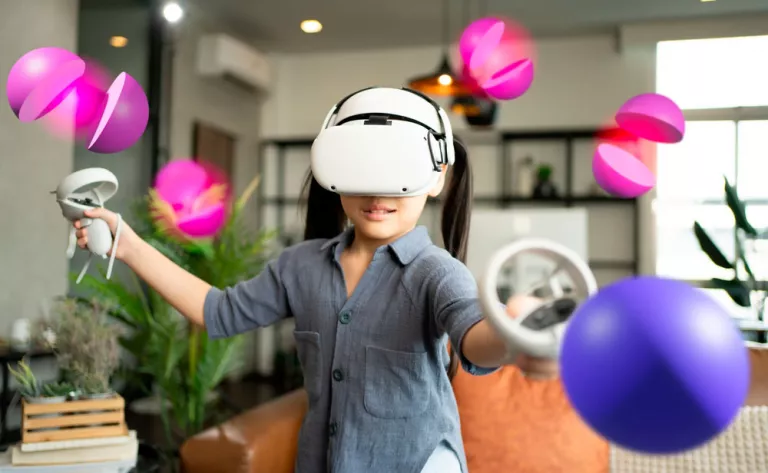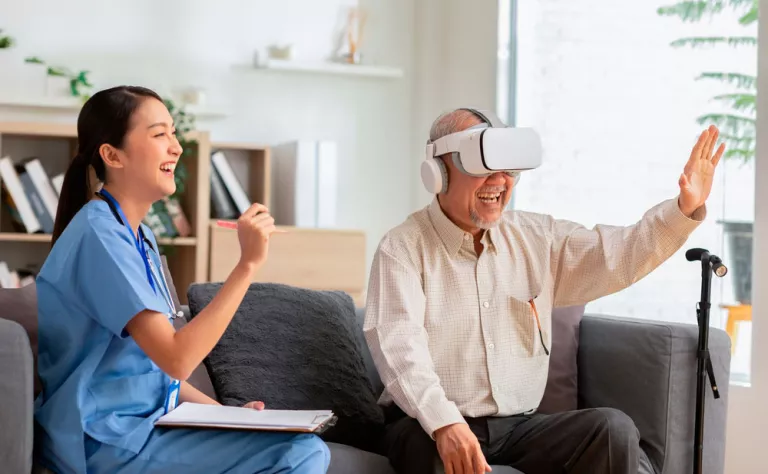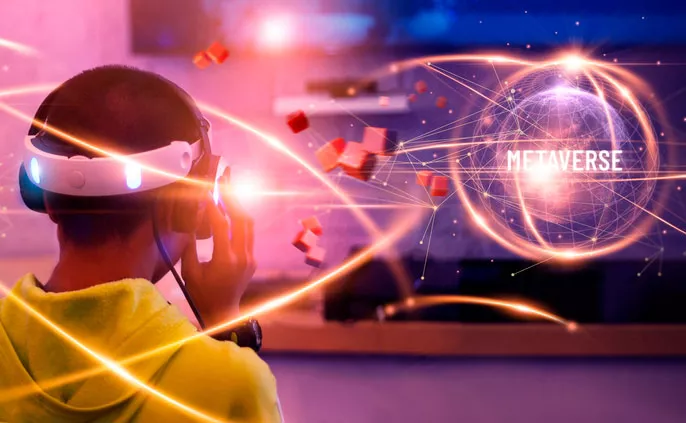You may have heard the word metaverse somewhere but you still don’t know very well what the topic is about. Eduardo Tornos y de Inza, an expert in digital marketing, describes it as “a site, a persistent and interoperable virtual reality (an artificial world) that will be generated in real time and that anyone can experience simultaneously if they have an internet connection and a suitable device”, although he recognizes that the metaverse cannot be described in only one way and that there are almost more people trying to explain it than exploring its possibilities.
But to get a rough idea, one could say that it is a kind of parallel environment thanks to augmented or virtual reality, a mix between social media and a massive online video game, which is achieved thanks to devices such as virtual glasses, a mobile, a tablet or a computer.
In the metaverse, each person is represented with an avatar, which can be faithful to reality or modified to taste, and through these virtual or augmented reality glasses we can interact with other users, for example, to talk with friends, work with our colleagues , visit places, or live totally realistic experiences, such as going to a doctor’s office open 24 hours, and all this without having to leave the site.
The metaverse is a parallel environment of augmented or virtual reality, a mixture of social media and a massive online video game accessed with electronic devices, such as virtual glasses.
Sounds like something from the movies, right? And it still is to a certain extent, as there is much to develop from the metaverse; This, as explained by Eduardo Tornos y de Inza, is similar to what happened to us with the Internet, when we went from being able to use it only on computers to having it in our own pockets. The metaverse allows you to be on the internet and interact with the digital in person, he clarifies. Some current means of access to the metaverse, to give us an idea of what it would be like, are Minecraft games, a concert in Fornite or a visit to the Prado Museum in Animal Crossing.

This concept, and everything it includes, is promising in many aspects, but we are going to focus on what the metaverse can do in the health environment, although, as Eduardo already warns us: “Imagine what health care will be like there, its effectiveness, its legal and ethical implications… belongs to the realm of science fiction”, for now… but the world flies by.
But what can the metaverse do for your health?
On October 28, Mark Zuckerberg announced the launch of Facebook’s metaverse, which consists of an always connected virtual universe that represents a great digital transformation since the arrival of the internet in our lives. If it were to be successful, ten years from now, the borders between the real, analog world and the virtual world could disappear forever, and things we do in person, like visiting a medical specialist, we could do in person. this kind of Matrix, although this, as some experts already warn, can also pose a greater risk to physical and mental health for various reasons (sedentary lifestyle, addictions, loneliness, abuse or virtual harassment…).
Although on the other hand, even from the World Health Organization (WHO) they explain that “advances in the area of big data and artificial intelligence have opened up new opportunities to monitor health and combat non-communicable diseases. Governments and decision-makers in the WHO European Region can use the data to control digital environments.”
On these platforms, you can do everything from performing an operation in the operating room without risk to discovering what an ICU is like or how to prepare to work in one of them
Thinking about what health care will be like in the metaverse that does not exist, and that we do not know if it will exist, can take up a lot of time and nothing would be concrete; Therefore, it is better that we review some of the uses of the available technology and that it is adding value in the world of health through the virtualization of some dynamics of the physical world, explains Eduardo.
Thus, on these platforms you can do everything from performing an operation in an operating room, without risk, to discovering what an ICU is like or how to prepare to work in one of them. This has the great advantage that it helps to train all those health workers without any kind of risk and in a very real way. In Europe alone, it is estimated that there are about 95,000 deaths due to medical errors. “I think that the value that virtual reality (VR) and augmented reality (AR) provides in the training of health professionals is not debatable. You can get an idea of its impact by seeing what platforms such as Ossovr, Vrhealth.institute or Immersium Studio are doing in the virtualization of work dynamics in the operating room or in the training of emergency care teams”, the marketing expert tells us; now nursing, medicine or physiotherapy students have different ways of approaching anatomy subjects thanks to these new technologies.

But it doesn’t end there, it also allows you to attend congresses and scientific meetings without having to travel, which represents great economic and environmental savings without losing the feeling of being in the same place accompanied by people.
Today virtual reality and augmented reality are already being used for things as varied as:
- Help in performing surgical techniques, better planning surgeries.
- Support for rehabilitation and physiotherapy therapies.
- A tool to treat phobias and addictions, doing therapy through avatars, which reduces fear or shame.
- Performing medical tests such as colonoscopy.
- Means to entertain children in medical actions, which reduces their perception of pain and anxiety.
- Its application is being investigated in the treatment of phantom limb pain, cancer pain and palliative care, among others.
Regarding the latter, Eduardo Tornos explains that last November the United States Food and Drug Administration (FDA) approved the relievrx.com Ease VRx program for the recovery of patients with chronic low back pain. Only in Pubmed, a well-known search engine for scientific studies, there are more than 900 articles on the use of virtual reality applied to the treatment of acute and chronic pain, the first publication being in 2000.
Health risks of the metaverse
Although the metaverse seems very promising in the face of possible applications for health, it also carries some risks that must be known. We must not forget that augmented or virtual reality is carried out in a static way, which can end up increasing the time we are without moving. This inaction can lead to a sedentary lifestyle that damages health and increases the risk of overweight and obesity.
Dr. Kremlin Wickramasinghe, Acting Head of the WHO European Office for the Environment, Prevention and Control of Noncommunicable Diseases, has stated that “Spending more time online connected to the metaverse with devices can reduce levels of physical activity and provide advertisers with many more ways to promote unhealthy products such as junk food, tobacco or alcohol”, so regulation in this regard would be necessary.
The augmented reality of the metaverse is generally performed in a static way, so it can increase the risk of sedentary lifestyle, overweight and obesity
“Although much is being written about consultations in the metaverse, I have doubts about the value that virtual encounters can bring through avatars of patients and health professionals… Without going into ethical or legal aspects, can metaconsultation add something in terms of efficiency, time savings, improvement of diagnosis, or provision of services to teleconsultation or video call?”, reflects Eduardo Tornos.

Another drawback that the metaverse could have is that it is believed that a large number of micropayments will be established, for example, it will cost money to change the clothes of our avatars, build something, or make some plan in virtual reality, all the same as if Let’s do it in real life. This may mean that many people are left out of their access a priori, or that even another, as is the case with online gambling, may fall into dangerous waste.
All this is still assumptions, but there is still much to discover about this new type of life 4.0. “Training, training in hard and soft skills, work spaces and meetings between professionals, research, treatments… The metaverse, considered as that different way of carrying out activities in and with the support of digital, is adding value to the world of health. Although there are still years to go before we can see the metaverse that films present us, we can now explore the possibilities offered by the virtualization of different dynamics of the physical world”, explains Eduardo, do you dare to explore them?
.














